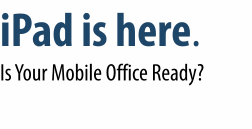











 The Future of Medical Technology Innovations
The Future of Medical Technology Innovations














 © Copyrighted 2010. All Rights Reserved.
© Copyrighted 2010. All Rights Reserved.









 Find Money in Your Practice
How to get paid for online consults
Technically Speaking. By Pamela Lewis Dolan, amednews staff. Posted March 22, 2010
http://www.ama-assn.org/amednews/2010/03/22/bica0322.htm
A growing number of insurers are paying for online communication between physicians and
patients. And when insurers don't cover it, many patients are willing to pay out of pocket for
the convenience. But either way, expert say, a clear plan and set of procedures can help
ensure that physicians get paid for their online consultations.
"There's a couple of hoops that you have to jump through, but even if it's not paid by the
insurance company, if it's something a physician wants to do in his practice and he's savvy
enough to want to use his e-mail, the cost can be carried on to the patients," said Rhonda
Buckholtz, vice president of business and member development for the American Academy of
Professional Coders. "All they have to do is set up policies and procedures."
E-mail exchanges between physicians and patients are considered billable online
consultations when they address a specific problem not associated with a prior visit, online or
in-office, within the previous seven days. E-mails sent within seven days of a prior visit, such
as those following up on labs, prescriptions or treatment questions, cannot be billed
separately.
The LoCicero Medical Group, a four-physician internal medicine practice in Tampa, Fla., is
among the one-third of physicians who, according to Manhattan Research, say they
communicate electronically with patients. The practice started doing online consults through
RelayHealth, an online Web visit tool, three years ago, and has been able to generate
revenue three different ways, said LoCicero CEO Nicholas Galantino.
The group offers online consults to self-pay patients for $30, which is collected online by
RelayHealth and paid to the practice monthly in a lump check. If the patient's insurer covers
online communications, the practice bills the plan, as it would for an in-office visit. The
practice also extended its weight-management services to include unlimited online consults
and e-mails for a monthly fee of $30.
Charles Thomason, president of Medical Management Associates, an Atlanta-based practice
management consultancy firm, said another option for physicians whose contracted payers
don't cover online consults is a quasi-concierge arrangement. Insured patients pay annual
"convenience fees" that allow for unlimited e-mails, texts and phone calls with physicians
along with other conveniences, such as same-day appointments. LifeScape Medical
Associates, a five-physician family practice in Scottsdale, Ariz., took this approach.
Susan Wilder, MD, a physician at LifeScape, said she started e-mail communications with
patients about six years ago. None of the practice's contracted insurers covered online
consultations, so patients self-paid online. Dr. Wilder later switched to an electronic medical
records system that had a built-in patient portal but no mechanism to bill patients online at the
time of service. So she set up a separate system allowing unlimited two-way communication
for patients who pay an annual fee.
Thomason said many patients are willing to pay for this unlimited-communication option but
warned that some managed care companies don't allow practices to offer it.
Fees charged patients for online visits are usually about the same as the patient's co-pay,
Thomason said. If billing for those services goes through the traditional process, which
requires employee time, the practice likely would lose money on online consults.
Buckholtz said practices should be aware of which health plans cover online consults so
patients aren't surprised when it comes time to pay. She also said patients should sign a
consent form describing what services can be rendered through online consults and how
these services are billed.
Practices also must establish a turnaround time for e-mails. LoCicero set its standard as eight
business hours, so an e-mail sent after hours on a Friday wouldn't require action until Monday
morning. But Galantino said the physicians, who alternate responsibility for online activities,
try to get back to patients as soon as possible, even on weekends.
Indianapolis-based WellPoint has several pilot programs using RelayHealth, which is also
provided by Aetna to its members. Blue Shield of California started an e-mail consult program
for its members in January. Its personal health record platform includes a built-in patient-
physician communication tool system called Patient Ally, which is similar to RelayHealth.
Patients first must answer a series of questions before a request is sent to the physician,
ensuring that they are eligible for online care and do not require an in-clinic visit.
Jim Orchison, director of network design and programs for Blue Shield, said it decided to go
with Patient Ally because of the online pre-screening tool.
Buckholtz said that, according to CPT code 99444, certain criteria need to be met by
practices when billing for online consults:
The code must not refer to a previous E&M service performed and reported by the physician
within the previous seven days, or within a postoperative recovery period. If it does, the
service is considered part of the previous E&M service and cannot be recorded separately.
The code should be recorded only once and encompass all of the communication related to
that e-visit, including telephone calls, prescription medication provisions and lab orders.
The visit must be made part of the patient record.
Galantino of LoCicero said that although online services never will replace in-office visits,
they have generated a new source of revenue for the practice. While that revenue is not yet
substantial, he expects it to grow. Allowing some patients to be cared for outside the office
also has freed up time for support staff.
Physicians in the practice were leery at first, Galantino said. But they quickly realized that the
online activities take only a few minutes and are a huge satisfaction-booster for patients.
"It's one of those things that's not time-consuming for practices. And if they follow the
guidelines and actually do the legwork to set it up, it can work," Buckholtz said.
Find Money in Your Practice
How to get paid for online consults
Technically Speaking. By Pamela Lewis Dolan, amednews staff. Posted March 22, 2010
http://www.ama-assn.org/amednews/2010/03/22/bica0322.htm
A growing number of insurers are paying for online communication between physicians and
patients. And when insurers don't cover it, many patients are willing to pay out of pocket for
the convenience. But either way, expert say, a clear plan and set of procedures can help
ensure that physicians get paid for their online consultations.
"There's a couple of hoops that you have to jump through, but even if it's not paid by the
insurance company, if it's something a physician wants to do in his practice and he's savvy
enough to want to use his e-mail, the cost can be carried on to the patients," said Rhonda
Buckholtz, vice president of business and member development for the American Academy of
Professional Coders. "All they have to do is set up policies and procedures."
E-mail exchanges between physicians and patients are considered billable online
consultations when they address a specific problem not associated with a prior visit, online or
in-office, within the previous seven days. E-mails sent within seven days of a prior visit, such
as those following up on labs, prescriptions or treatment questions, cannot be billed
separately.
The LoCicero Medical Group, a four-physician internal medicine practice in Tampa, Fla., is
among the one-third of physicians who, according to Manhattan Research, say they
communicate electronically with patients. The practice started doing online consults through
RelayHealth, an online Web visit tool, three years ago, and has been able to generate
revenue three different ways, said LoCicero CEO Nicholas Galantino.
The group offers online consults to self-pay patients for $30, which is collected online by
RelayHealth and paid to the practice monthly in a lump check. If the patient's insurer covers
online communications, the practice bills the plan, as it would for an in-office visit. The
practice also extended its weight-management services to include unlimited online consults
and e-mails for a monthly fee of $30.
Charles Thomason, president of Medical Management Associates, an Atlanta-based practice
management consultancy firm, said another option for physicians whose contracted payers
don't cover online consults is a quasi-concierge arrangement. Insured patients pay annual
"convenience fees" that allow for unlimited e-mails, texts and phone calls with physicians
along with other conveniences, such as same-day appointments. LifeScape Medical
Associates, a five-physician family practice in Scottsdale, Ariz., took this approach.
Susan Wilder, MD, a physician at LifeScape, said she started e-mail communications with
patients about six years ago. None of the practice's contracted insurers covered online
consultations, so patients self-paid online. Dr. Wilder later switched to an electronic medical
records system that had a built-in patient portal but no mechanism to bill patients online at the
time of service. So she set up a separate system allowing unlimited two-way communication
for patients who pay an annual fee.
Thomason said many patients are willing to pay for this unlimited-communication option but
warned that some managed care companies don't allow practices to offer it.
Fees charged patients for online visits are usually about the same as the patient's co-pay,
Thomason said. If billing for those services goes through the traditional process, which
requires employee time, the practice likely would lose money on online consults.
Buckholtz said practices should be aware of which health plans cover online consults so
patients aren't surprised when it comes time to pay. She also said patients should sign a
consent form describing what services can be rendered through online consults and how
these services are billed.
Practices also must establish a turnaround time for e-mails. LoCicero set its standard as eight
business hours, so an e-mail sent after hours on a Friday wouldn't require action until Monday
morning. But Galantino said the physicians, who alternate responsibility for online activities,
try to get back to patients as soon as possible, even on weekends.
Indianapolis-based WellPoint has several pilot programs using RelayHealth, which is also
provided by Aetna to its members. Blue Shield of California started an e-mail consult program
for its members in January. Its personal health record platform includes a built-in patient-
physician communication tool system called Patient Ally, which is similar to RelayHealth.
Patients first must answer a series of questions before a request is sent to the physician,
ensuring that they are eligible for online care and do not require an in-clinic visit.
Jim Orchison, director of network design and programs for Blue Shield, said it decided to go
with Patient Ally because of the online pre-screening tool.
Buckholtz said that, according to CPT code 99444, certain criteria need to be met by
practices when billing for online consults:
The code must not refer to a previous E&M service performed and reported by the physician
within the previous seven days, or within a postoperative recovery period. If it does, the
service is considered part of the previous E&M service and cannot be recorded separately.
The code should be recorded only once and encompass all of the communication related to
that e-visit, including telephone calls, prescription medication provisions and lab orders.
The visit must be made part of the patient record.
Galantino of LoCicero said that although online services never will replace in-office visits,
they have generated a new source of revenue for the practice. While that revenue is not yet
substantial, he expects it to grow. Allowing some patients to be cared for outside the office
also has freed up time for support staff.
Physicians in the practice were leery at first, Galantino said. But they quickly realized that the
online activities take only a few minutes and are a huge satisfaction-booster for patients.
"It's one of those things that's not time-consuming for practices. And if they follow the
guidelines and actually do the legwork to set it up, it can work," Buckholtz said.

 IT Solutions
IT Solutions
 Allscripts EHR
Allscripts EHR
 Physicians eServices
Physicians eServices
 EHR Stimulus Breaking News
EHR Stimulus Breaking News















 The Future of Medical Technology Innovations
The Future of Medical Technology Innovations














 © Copyrighted 2010. All Rights Reserved.
© Copyrighted 2010. All Rights Reserved.









 Find Money in Your Practice
How to get paid for online consults
Technically Speaking. By Pamela Lewis Dolan, amednews staff. Posted March 22, 2010
http://www.ama-assn.org/amednews/2010/03/22/bica0322.htm
A growing number of insurers are paying for online communication between physicians and
patients. And when insurers don't cover it, many patients are willing to pay out of pocket for
the convenience. But either way, expert say, a clear plan and set of procedures can help
ensure that physicians get paid for their online consultations.
"There's a couple of hoops that you have to jump through, but even if it's not paid by the
insurance company, if it's something a physician wants to do in his practice and he's savvy
enough to want to use his e-mail, the cost can be carried on to the patients," said Rhonda
Buckholtz, vice president of business and member development for the American Academy of
Professional Coders. "All they have to do is set up policies and procedures."
E-mail exchanges between physicians and patients are considered billable online
consultations when they address a specific problem not associated with a prior visit, online or
in-office, within the previous seven days. E-mails sent within seven days of a prior visit, such
as those following up on labs, prescriptions or treatment questions, cannot be billed
separately.
The LoCicero Medical Group, a four-physician internal medicine practice in Tampa, Fla., is
among the one-third of physicians who, according to Manhattan Research, say they
communicate electronically with patients. The practice started doing online consults through
RelayHealth, an online Web visit tool, three years ago, and has been able to generate
revenue three different ways, said LoCicero CEO Nicholas Galantino.
The group offers online consults to self-pay patients for $30, which is collected online by
RelayHealth and paid to the practice monthly in a lump check. If the patient's insurer covers
online communications, the practice bills the plan, as it would for an in-office visit. The
practice also extended its weight-management services to include unlimited online consults
and e-mails for a monthly fee of $30.
Charles Thomason, president of Medical Management Associates, an Atlanta-based practice
management consultancy firm, said another option for physicians whose contracted payers
don't cover online consults is a quasi-concierge arrangement. Insured patients pay annual
"convenience fees" that allow for unlimited e-mails, texts and phone calls with physicians
along with other conveniences, such as same-day appointments. LifeScape Medical
Associates, a five-physician family practice in Scottsdale, Ariz., took this approach.
Susan Wilder, MD, a physician at LifeScape, said she started e-mail communications with
patients about six years ago. None of the practice's contracted insurers covered online
consultations, so patients self-paid online. Dr. Wilder later switched to an electronic medical
records system that had a built-in patient portal but no mechanism to bill patients online at the
time of service. So she set up a separate system allowing unlimited two-way communication
for patients who pay an annual fee.
Thomason said many patients are willing to pay for this unlimited-communication option but
warned that some managed care companies don't allow practices to offer it.
Fees charged patients for online visits are usually about the same as the patient's co-pay,
Thomason said. If billing for those services goes through the traditional process, which
requires employee time, the practice likely would lose money on online consults.
Buckholtz said practices should be aware of which health plans cover online consults so
patients aren't surprised when it comes time to pay. She also said patients should sign a
consent form describing what services can be rendered through online consults and how
these services are billed.
Practices also must establish a turnaround time for e-mails. LoCicero set its standard as eight
business hours, so an e-mail sent after hours on a Friday wouldn't require action until Monday
morning. But Galantino said the physicians, who alternate responsibility for online activities,
try to get back to patients as soon as possible, even on weekends.
Indianapolis-based WellPoint has several pilot programs using RelayHealth, which is also
provided by Aetna to its members. Blue Shield of California started an e-mail consult program
for its members in January. Its personal health record platform includes a built-in patient-
physician communication tool system called Patient Ally, which is similar to RelayHealth.
Patients first must answer a series of questions before a request is sent to the physician,
ensuring that they are eligible for online care and do not require an in-clinic visit.
Jim Orchison, director of network design and programs for Blue Shield, said it decided to go
with Patient Ally because of the online pre-screening tool.
Buckholtz said that, according to CPT code 99444, certain criteria need to be met by
practices when billing for online consults:
The code must not refer to a previous E&M service performed and reported by the physician
within the previous seven days, or within a postoperative recovery period. If it does, the
service is considered part of the previous E&M service and cannot be recorded separately.
The code should be recorded only once and encompass all of the communication related to
that e-visit, including telephone calls, prescription medication provisions and lab orders.
The visit must be made part of the patient record.
Galantino of LoCicero said that although online services never will replace in-office visits,
they have generated a new source of revenue for the practice. While that revenue is not yet
substantial, he expects it to grow. Allowing some patients to be cared for outside the office
also has freed up time for support staff.
Physicians in the practice were leery at first, Galantino said. But they quickly realized that the
online activities take only a few minutes and are a huge satisfaction-booster for patients.
"It's one of those things that's not time-consuming for practices. And if they follow the
guidelines and actually do the legwork to set it up, it can work," Buckholtz said.
Find Money in Your Practice
How to get paid for online consults
Technically Speaking. By Pamela Lewis Dolan, amednews staff. Posted March 22, 2010
http://www.ama-assn.org/amednews/2010/03/22/bica0322.htm
A growing number of insurers are paying for online communication between physicians and
patients. And when insurers don't cover it, many patients are willing to pay out of pocket for
the convenience. But either way, expert say, a clear plan and set of procedures can help
ensure that physicians get paid for their online consultations.
"There's a couple of hoops that you have to jump through, but even if it's not paid by the
insurance company, if it's something a physician wants to do in his practice and he's savvy
enough to want to use his e-mail, the cost can be carried on to the patients," said Rhonda
Buckholtz, vice president of business and member development for the American Academy of
Professional Coders. "All they have to do is set up policies and procedures."
E-mail exchanges between physicians and patients are considered billable online
consultations when they address a specific problem not associated with a prior visit, online or
in-office, within the previous seven days. E-mails sent within seven days of a prior visit, such
as those following up on labs, prescriptions or treatment questions, cannot be billed
separately.
The LoCicero Medical Group, a four-physician internal medicine practice in Tampa, Fla., is
among the one-third of physicians who, according to Manhattan Research, say they
communicate electronically with patients. The practice started doing online consults through
RelayHealth, an online Web visit tool, three years ago, and has been able to generate
revenue three different ways, said LoCicero CEO Nicholas Galantino.
The group offers online consults to self-pay patients for $30, which is collected online by
RelayHealth and paid to the practice monthly in a lump check. If the patient's insurer covers
online communications, the practice bills the plan, as it would for an in-office visit. The
practice also extended its weight-management services to include unlimited online consults
and e-mails for a monthly fee of $30.
Charles Thomason, president of Medical Management Associates, an Atlanta-based practice
management consultancy firm, said another option for physicians whose contracted payers
don't cover online consults is a quasi-concierge arrangement. Insured patients pay annual
"convenience fees" that allow for unlimited e-mails, texts and phone calls with physicians
along with other conveniences, such as same-day appointments. LifeScape Medical
Associates, a five-physician family practice in Scottsdale, Ariz., took this approach.
Susan Wilder, MD, a physician at LifeScape, said she started e-mail communications with
patients about six years ago. None of the practice's contracted insurers covered online
consultations, so patients self-paid online. Dr. Wilder later switched to an electronic medical
records system that had a built-in patient portal but no mechanism to bill patients online at the
time of service. So she set up a separate system allowing unlimited two-way communication
for patients who pay an annual fee.
Thomason said many patients are willing to pay for this unlimited-communication option but
warned that some managed care companies don't allow practices to offer it.
Fees charged patients for online visits are usually about the same as the patient's co-pay,
Thomason said. If billing for those services goes through the traditional process, which
requires employee time, the practice likely would lose money on online consults.
Buckholtz said practices should be aware of which health plans cover online consults so
patients aren't surprised when it comes time to pay. She also said patients should sign a
consent form describing what services can be rendered through online consults and how
these services are billed.
Practices also must establish a turnaround time for e-mails. LoCicero set its standard as eight
business hours, so an e-mail sent after hours on a Friday wouldn't require action until Monday
morning. But Galantino said the physicians, who alternate responsibility for online activities,
try to get back to patients as soon as possible, even on weekends.
Indianapolis-based WellPoint has several pilot programs using RelayHealth, which is also
provided by Aetna to its members. Blue Shield of California started an e-mail consult program
for its members in January. Its personal health record platform includes a built-in patient-
physician communication tool system called Patient Ally, which is similar to RelayHealth.
Patients first must answer a series of questions before a request is sent to the physician,
ensuring that they are eligible for online care and do not require an in-clinic visit.
Jim Orchison, director of network design and programs for Blue Shield, said it decided to go
with Patient Ally because of the online pre-screening tool.
Buckholtz said that, according to CPT code 99444, certain criteria need to be met by
practices when billing for online consults:
The code must not refer to a previous E&M service performed and reported by the physician
within the previous seven days, or within a postoperative recovery period. If it does, the
service is considered part of the previous E&M service and cannot be recorded separately.
The code should be recorded only once and encompass all of the communication related to
that e-visit, including telephone calls, prescription medication provisions and lab orders.
The visit must be made part of the patient record.
Galantino of LoCicero said that although online services never will replace in-office visits,
they have generated a new source of revenue for the practice. While that revenue is not yet
substantial, he expects it to grow. Allowing some patients to be cared for outside the office
also has freed up time for support staff.
Physicians in the practice were leery at first, Galantino said. But they quickly realized that the
online activities take only a few minutes and are a huge satisfaction-booster for patients.
"It's one of those things that's not time-consuming for practices. And if they follow the
guidelines and actually do the legwork to set it up, it can work," Buckholtz said.

 IT Solutions
IT Solutions
 Allscripts EHR
Allscripts EHR
 Physicians eServices
Physicians eServices
 EHR Stimulus Breaking News
EHR Stimulus Breaking News










